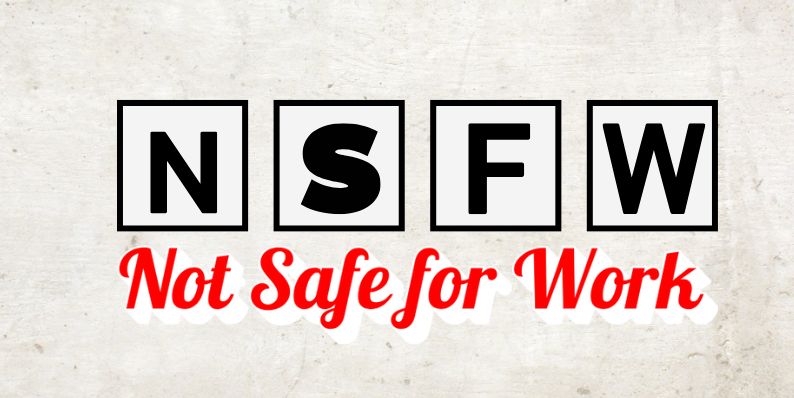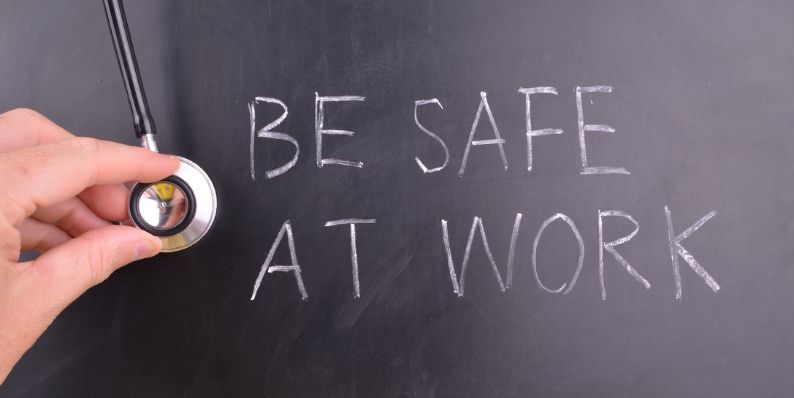You might see the letters NSFW online quite often. People use them in messages, on pictures, or in online posts. NSFW stands for “Not Safe for Work.” When people use NSFW, they are giving you a heads-up. They are warning you that what they are sharing might not be okay to look at if you are in a public place or a professional place, like an office or at school. These warnings help you avoid embarrassing moments, especially when others are around.
The NSFW label does not always mean that something is illegal or trying to cause harm. Sometimes, people use it for topics that are sensitive, or just meant for adults. When you understand what this NSFW tag means and how people use it, you can make smarter choices about what you click on or look at online.
So, What Does NSFW Really Mean?
 NSFW means “Not Safe for Work.” It is a label for things online that might not be good to open when you are around other people, especially at your job or in a public spot. This can include many types of content. For example, it could be videos, pictures, links to websites, or even text messages that talk about:
NSFW means “Not Safe for Work.” It is a label for things online that might not be good to open when you are around other people, especially at your job or in a public spot. This can include many types of content. For example, it could be videos, pictures, links to websites, or even text messages that talk about:
- Pictures or discussions about bodies without clothes or sexual topics
- Strong bad words
- Seeing violence or bloody images
- Talk about using drugs
- Anything else that someone might find upsetting or too sensitive for everyone to see
This term, NSFW, started on the internet. People first used it in online groups and on websites like Reddit. Now, you see it everywhere. People use it in text messages, on social media sites like Twitter/X, in funny internet pictures called memes, in emails, and in comments on posts. It works like a friendly warning. It tells others to be careful and maybe wait to open the content when they are in a private place, not during a work meeting or when kids might see it.
Where Will You See NSFW Tags?
You can find NSFW tags in many places online. Often, you will see this warning before you click on something. This gives you a chance to decide if you want to see it. Here are some common places:
- Text messages and private chats: Your friends might type “NSFW” before they send you a funny picture or a link that might be a bit risky.
- Reddit: On this website, users can mark their posts as NSFW. If they do, the post might look blurry until you choose to see it, or if you change your settings.
- Twitter/X: This site often hides content it thinks is sensitive. You usually have to click a button to agree to see it.
- Instagram: Some photos or videos on Instagram might be blurred. They will also have a warning if the person who posted them, or Instagram itself, marks them as sensitive.
- Discord: On this chat service, whole channels or sections can be labeled NSFW. Usually, you have to say you are old enough to enter these channels.
- Email subject lines: Sometimes, people will write “NSFW” in the subject of an email. This tells you that something in the email, like a picture or a link, might not be good to open at work.
The NSFW label helps people avoid opening something they should not, especially when they are in a public area or at work.
What Kind of Things Get Marked NSFW?
 Not everything called NSFW is the same. What one person thinks is NSFW, another person might not. It also depends on the website or app you are using and where you are. But, here are some general examples of content that people often mark as NSFW:
Not everything called NSFW is the same. What one person thinks is NSFW, another person might not. It also depends on the website or app you are using and where you are. But, here are some general examples of content that people often mark as NSFW:
- Images or videos that show sexual acts.
- Photos, drawings, or other media that show people without clothes.
- Videos or pictures that show blood, violence, or injuries from accidents or medical things.
- The use of swear words, mean names for groups of people (slurs), or speech that shows hate.
- Posts or talks about drugs or using drugs.
- Jokes about dark topics or politics that could make some people upset.
Remember, an NSFW tag does not always mean something is truly terrible. Sometimes, it just means “look at this with care, and think about where you are before you open it.”
Is NSFW Always a “Bad” Thing?
No, not really. The word NSFW is just a warning that the content might not be right for every place or every person. Some things marked NSFW can even be for education or art. For instance:
- Videos that train doctors and show surgeries.
- Drawings or pictures that show the parts of the human body for learning.
- Materials for adult education classes.
This warning helps stop people from being surprised by what they see. It gives them a choice. Using the NSFW tag is often about being polite and careful. It is not always about trying to block something completely.
SFW vs. NSFW vs. NSFL: What’s the Difference?
You might see these three terms online. They help people quickly understand what kind of content to expect:
- SFW (Safe for Work): This means it is okay to look at the content in public places or at your job.
- NSFW (Not Safe for Work): This means the content might have things like nudity, violence, or strong bad words. So, be careful where you open it.
- NSFL (Not Safe for Life): This warning is for content that is very graphic, upsetting, or could make you feel really bad. It is much more serious than NSFW. NSFL content is usually meant only for adults who understand it could be disturbing.
Websites and apps use these terms to label posts. Some will automatically blur or hide NSFW or NSFL content. Other times, people need to add these warnings themselves. If you see something marked NSFL, you should be extra careful because it is usually much stronger than regular NSFW content.
What Should You Do If You See NSFW Content?
When you come across NSFW content online, here are a few things you can do:
- Think before you click. Do not open NSFW links, pictures, or files when you are at work or school.
- Use safety settings. Many sites like YouTube have a “Restricted Mode.” Reddit lets you blur NSFW content. Use these settings if they help you.
- Report or hide things you do not like. If you see content that makes you uncomfortable or breaks rules, most platforms let you report it or hide it from your view.
- Think about privacy tools. You can use browser tools or apps that block certain types of content if you want to avoid it.
- Talk to people in group chats. If you are in a group chat where people share things, it is okay to talk about what everyone is comfortable with sharing.
Most online platforms give you some control over what you see. Parents can also use special parental control tools on phones and computers to help filter what their kids can access.
Can You Use NSFW in Work Settings?
It is usually best not to use or send NSFW content in professional or work settings. Just adding an “NSFW” warning to a message does not make it okay to send adult or graphic things in work emails. This also applies to team chat apps like Slack or Microsoft Teams.
Most workplaces have rules against sharing NSFW material. If you share it, you might break these rules. It could also make your workplace feel uncomfortable or even hostile for others. Even if you think the content is just a joke or a funny meme, it can still offend people or cause serious problems.
If you are not sure if something is okay to send at work, it is safer to just not send it. Keep your personal sharing private. Save sensitive pictures or jokes for your close friends, and not for your work chats.
Final Thoughts on NSFW
So, to sum it up, NSFW means “Not Safe for Work.” It is a tag people use online to warn others about sensitive content. This content might not be okay to look at in public places or at your job. You will see this tag in text messages, on social media, in chat rooms, and on websites.
When you understand what NSFW means, it helps you act respectfully and stay safer online. It does not matter if you are the one sending content or the one seeing it. Always think about where you are and who else might see what is on your screen. It is always a good idea to give a warning if content might be sensitive. Sometimes, it is even better not to send it at all if you are not sure.
Have you seen the NSFW tag used in a funny or strange way online? Feel free to share your story in the comments section below! And, if this guide helped you understand NSFW better, please think about sharing it with a friend who might also find it useful.




